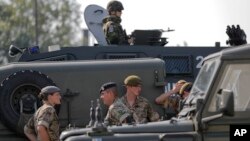Thousands of troops from NATO and its partner nations are training on land and sea in central and eastern Europe Thursday, in two major exercises that aim to demonstrate their cooperation and rapid response capabilities at a time when the region feels threatened by Russia.
Around 4,000 U.S. and European troops from 14 nations took part in the annual Baltic Operations navy exercise that opened Thursday in Poland's Baltic Sea port of Szczecin. The 45th edition of the so-called BALTOPS exercise involves maritime, air and ground forces with about 50 ships and submarines and over 50 aircraft, and will run through June 16.
The training includes "tracking down and fighting submarines and sea mines, the use of air defense and landing troops as well as defense against navy vessels,'' said Lt. Cmdr. Jacek Kwiatkowski, spokesman for the exercise.
The European troops come from Belgium, Denmark, Estonia, Finland, France, the Netherlands, Lithuania, Latvia, Germany, Norway, Britain, Sweden and host nation Poland.
BALTOPS began in 1972 as a NATO exercise. Former Eastern Bloc nations joined in 1993, as they opened efforts to become alliance members.
In Romania, meanwhile, another 2,000 soldiers, 1,000 assistance personnel and 500 vehicles from 11 NATO nations are training within the alliance's so-called "Noble Jump 2017" drill that opened in Greece Monday.
Poland, Romania and other countries on NATO's eastern flank are concerned for their security and defense following Russia's seizure of the Crimea Peninsula from Ukraine, and because of its support for rebels in eastern Ukraine and its air force activity over the Baltic Sea. To allay these concerns, NATO and the U.S. have deployed thousands of troops to the region and hold regular joint exercises there.
About 300 troops traveling in a military convoy arrived in Romania from Bulgaria on Thursday. Other troops are expected to join in from bases in Britain, Germany, the Netherlands, Spain, Poland, Norway and Albania.
Noble Jump aims to show the deployment skills of NATO's Very High Readiness Joint Task Force, established after the 2014 NATO summit in Wales, to provide rapid response to threats on NATO's eastern flank.
"While this is a first time that this particular set of exercises takes place in Romania, the desired effect is to practice the ability to deliver to our politicians the capability they've requested of us," Maj. Gen. Ian Cave, who commands the exercise, said in Giurgiu, on Romania's border with Bulgaria.
The Romanian Ground Forces Chief of Staff, Brig. Gen. Marius Harabagiu, said the exercise is "extremely important because it demonstrates the capacity and the speed of reaction of this alliance to prevent the threats we face in this moment."





